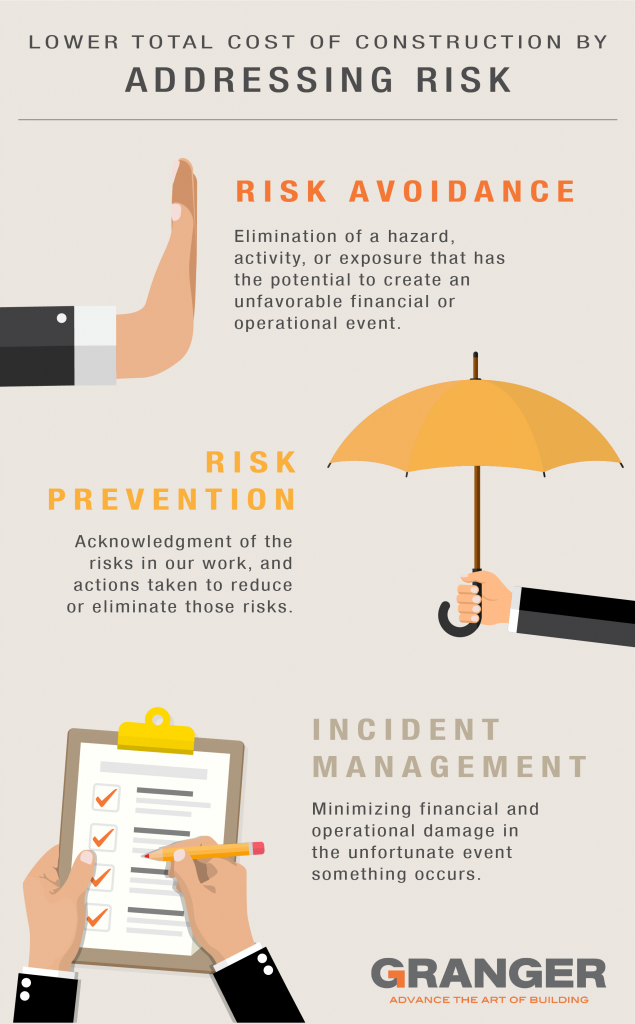Insurance rates affect construction costs for Owners across industries. But in hard markets, a Construction Manager’s (CM) proactive attention to risk prevention, avoidance and incident management is especially beneficial for maintaining lower total cost of construction.
INSURANCE PRACTICES
Most construction companies Granger’s size are self-insured. This means they have insurance in place to cover catastrophic losses, but pay the early part of most claims out-of-pocket.
“The more financial responsibility we assume initially, the lower our overall cost of risk will be,” notes Chris Duprey, Granger Construction Vice President and Chief Financial Officer. “Virtually no one is fully self-insured. The risk is too great. But you can take steps to maximize the value of your risk management dollar.”
Instead, most CMs buy reinsurance. This means the CM pays on claims up to a certain amount, and anything beyond that is picked up by a third party. When insurance markets harden, even costs for these reinsurance layers increase, ultimately increasing the total cost of construction for project Owners.
HARDENING INSURANCE MARKETS
Hard insurance markets are a result of two old economic standbys of supply and demand:
- Low Supply – Fewer insurance carriers are available that want to participate in a given market and/or their underwriting standards have tightened, causing an increase in price.
- High Demand – More people and organizations desire insurance, either due to construction market expansion or overall consumer flight from risk.
“What happens with hardened markets is the proverbial double thumbs-down,” says Duprey. “Everyone needs the insurance. But fewer carriers believe they can provide it profitably.”
Reasons for hard insurance markets may be seemingly unrelated to the local marketplace. For instance, global rates may increase to compensate for wildfires, hurricanes or other natural disasters. Of course, rates are often higher in major risk areas. But ultimately, everyone subsidizes the risks of the whole by paying a little extra.
“In the end, fluctuating rates are reflected in the total cost of construction,” continues Duprey. “Owners benefit when rates soften, but when the opposite occurs, they feel the impact. Companies strive for the lowest total cost of risk. However, insurance is just one component of this. It is also important to actively manage your losses. Our risk program, and by extension our Owners, benefit from how we prevent and respond to claims.”

PROACTIVE RISK PREVENTION
“It’s during hard times when your processes and procedures are tested, and you discover if you are any good in terms of risk prevention, avoidance and management,” adds Granger Vice President and head of Risk Management, Tim VanAntwerp. “Anything we can do to proactively address and prevent risks at Granger is beneficial to us and ultimately our clients.”
Here are some of the proactive processes we are implementing at Granger Construction:
- Risk Assessments – On complicated projects presenting unusual internal and/or external risks, Granger project teams begin by conducting Risk Assessments. As the name implies, a good Risk Assessment involves meeting with Owners, Architects and relevant Subject Matter Experts early in pre-construction and design planning. Working collaboratively, the team then populates robust lists of potential project risks, their likelihood of occurrence and mitigation plans for each. These mitigation plans may include administrative and contracting measures, team and personnel training, or in-depth site investigations and analysis using technology such as ground scans or 3-D modeling. We have even proactively invited our insurance company to conduct jobsite walks in instances when we identified significant potential for unusual site risks.
- Loss Control Committee – Multiple times each year, Granger invites all our insurance partners to the Lansing Headquarters to participate in our Loss Control Committee. We also include a rotating group of team members from the field and our leadership team. The goal of this committee is to discuss current market trends. What are the risks our insurers are seeing? What are the problems and risks our field teams are seeing, and have we experienced any issues throughout the year? Then we brainstorm solutions to improve and drive risk out of our projects.
- Investment in Lean – Using Lean to improve communication and accountability at the site leadership level helps break down silos between design, construction and constructability. This, in turn, helps reduce risks related to design conflicts or constructability conflicts (ex. envelope, sequencing, etc.). Our investment in Lean is largely about team improvement and schedule improvement. But it is also part of our risk management approach. Overall, it helps us reduce risk and complete projects with fewer issues, fewer claims and lower costs.
- Enhanced Execution Planning Process – Granger Vice President of Operations, Rob Train, has led an initiative to continually improve Execution Plans for every Granger project. As our teams assemble their client, schedule, safety, flow and sequence management plans, Granger leadership works with them to vet and improve these concepts. “To me, that’s something else that really helps our overall performance,” notes VanAntwerp. “It’s a good planning process and ensures our teams really understand the major things that could go wrong, or have gone wrong in the past and how they will proactively avoid, prevent and manage these risks.”
These are just a few examples of risk prevention processes we are implementing at Granger. To learn more and improve risk prevention on your next construction project, contact us today.



